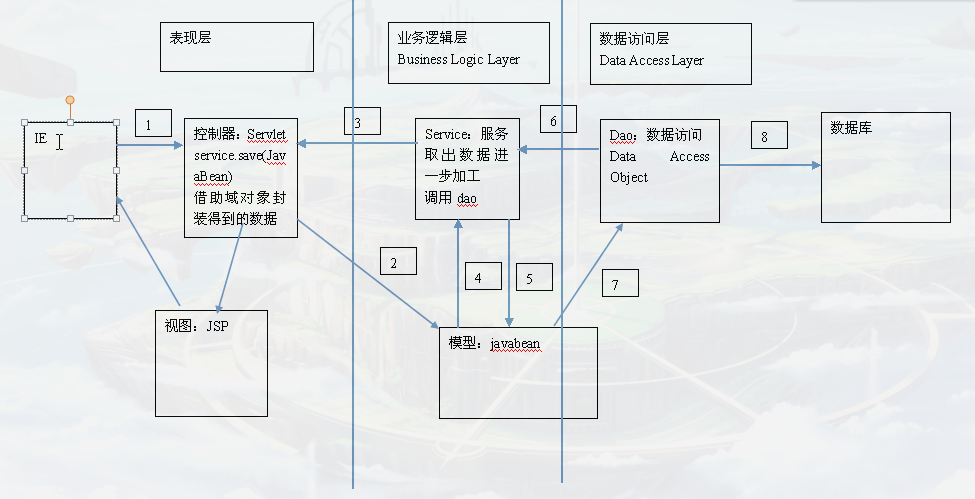传智播客day13-JSP&JavaBean
更新日期:
文章目录
JSP中的九大隐式对象
就是JSP对应的Servlet那些变量
1 2 3 4 5 6 7 8 9 | // JSP中可以取到的变量 PageContext pageContext = null; HttpSession session = null; ServletContext application = null; ServletConfig config = null; JspWriter out = null; Object page = this; JspWriter _jspx_out = null; PageContext _jspx_page_context = null; |
| 内置对象名称 | 对应的类型 | 备注 |
|---|---|---|
| request | javax.servlet.http.HttpServletRequest | |
| response | javax.servlet.http.HttpServletResponse | |
| session | javax.servlet.http.HttpSession | jsp指令 session="true" |
| application | javax.servlet.ServletContext | |
| config | javax.servlet.ServletConfig | |
| page | java.lang.Object | 代表当前servlet对象本身 |
| exception | java.lang.Throwable | jsp指令 isErrorPage="true" |
| out | javax.servlet.jsp.JspWriter | 和 reponse.getWriter()一样 |
| pageContext | javax.servlet.jsp.PageContext |
隐式对象 out的使用
1 2 3 4 5 | <% out.write("123"); // JspWriter, 缓存8kb response.getWriter.write("456"); %> <!--结果是 456123--> |
pageContext 内置对象
作用:
是一个域对象, 存的数据只能是当前页面来访问. 还能操作其他三个域对象(ServletRequest, HttpSession, ServletContext)的数据
可以操作本身的域对象和其他的域对象
- setAttribute(String key, Object value, int scope)
- getAttribute(String key, int scope)
- removeAttribute(int scope)
- scope:
PageContext.PAGE_SCOPE,PageContext.REQUEST_SCOPE,PageContext.SESSION_SCOPE,PageContext.APPLICATION_SCOPE - findAttribute(String key), 依次从页面、请求、会话、应用范围找对应的值
获得其他8个隐式对象
pageContext.getRequest();pageContext.getSession();- ...
提供了转发和包含的简单方法
pageContext.forward("");pageContext.include("");
四大域对象
- PageContext: 页面范围的数据, 用的很少
- ServletRequest: 请求范围的数据, 用的很多. 显示一次数据后就没有用了
- HttpSession: 会话范围内的数据, 用的很多, 每次请求和响应都需要的共享数据
- ServletContext: 应用范围内的数据, 用的不多, 是所有的客户端都共享的信息. 注意同步!!!
数据能不能取到, 关键是不是从一个地方取的数据
JavaBean 概念
- 什么是JavaBean(VO, Value Object; DO: Data Object; POJO: 简单Java对象)
遵循一定的命名规则:
- 必须由默认的构造方法
- 类的声明为public类型
- 字段都是私有的
private boolean married; - 提供公有的getter或setter方法(属性)
- 一般实现 java.io.Serializable 接口
应用场景
封装数据, 便于传递数据
JavaWeb开发模型
模型一: JavaBean + JSP,只能开发很简单的应用,不适合企业级应用
模型二: MVC, Model+View+Controller
- Model: JavaBean 数据
- View: JSP
Controller: Servlet
MVC只是三层架构模式中的前段展示层
三层架构模型

在JSP中使用JavaBean
使用动作元素(内置标签)
jsp:useBean: 用于从指定范围根据名称查找Javabean, 如果没有找到, 创建该 JavaBean 的实例, 然后放到指定的范围.
1 2 3 4 5 6 7 8 9 10
<jsp:useBean id="p" class="cn.itcast.Person" scope="page|request|session|application"></jsp:useBean> <% // 等价代码 cn.itcast.Person p = null; p = (Person) pageContext.getAttribute("p", pageContext.PAGE_SCOPE); if(p==null){ p = new Person(); pageContext.setAttribute("p", p, pageContext.PAGE_SCOPE); } %>
jsp:setProperty: 给指定名称的对象设置值
1 2 3 4
<jsp:setProperty property="name" name="p" value="xxx"/> <%// 等价代码 p.setName("xxx"); %>
jsp:getProperty: 如果一个属性的值是null, 界面就会显示null
1 2
<jsp:getProperty property="name" name="p"/> <%=p.getName()%> <!-- 等价代码 -->
用请求参数设置 JavaBean 中的值
在模型一中用到
1 2 3 4 5 6 7 8 9 10 11 12 | <form action="Bean.jsp" method="post"> <input type="text" name="name"/> <input type="radio" name="gender" value="female"/> 先生 <input type="radio" name="gender" value="male"/> 小姐 <input type="submit"/> </form> <!-- Bean.jsp --> <jsp:setProperty property="name" name="p" param="name"/> <jsp:setProperty property="name" name="p" param="gender"/> <!-- 使用通配符, 简化上面调用, 前提: 表单的字段名和JavaBean的字段名一致 --> <jsp:setProperty property="*" name="p"/> |
